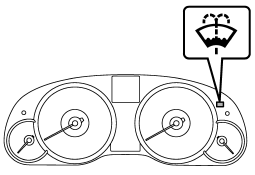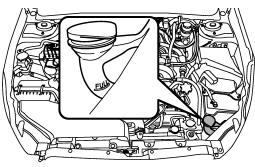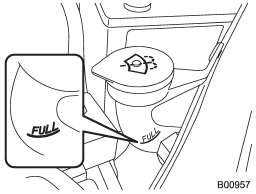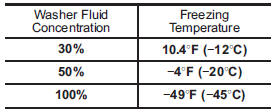Windshield washer fluid
CAUTION
Never use engine coolant as washer fluid because it could cause paint damage.

If you spray washer fluid on the windshield but the windshield washer fluid warning light illuminates or the supply of washer fluid runs out, add washer fluid in the tank.


Remove the washer tank filler cap, then add fluid until it reaches the “FULL” mark on the tank.
Use windshield washer fluid. If windshield washer fluid is unavailable use clean water.
In areas where water freezes in winter, use an anti-freeze type windshield washer fluid. SUBARU Windshield Washer Fluid contains 58.5% methyl alcohol and 41.5% surfactant, by volume. Its freezing temperature varies according to how much it is diluted, as indicated in the following table.

CAUTION
Never use engine coolant as washer fluid because it could cause paint damage.
In order to prevent freezing of washer fluid, check the freezing temperatures in the table above when adjusting the fluid concentration to the outside temperature.
If you fill the reservoir tank with a fluid with a different concentration from the one used previously, purge the old fluid from the piping between the reservoir tank and washer nozzles by operating the washer for a certain period of time. Otherwise, if the concentration of the fluid remaining in the piping is too low for the outside temperature, it may freeze and block the nozzles.
CAUTION
● Adjust the washer fluid concentration appropriately for the outside temperature. If the concentration is inappropriate, sprayed washer fluid may freeze on the windshield and obstruct your view, and the fluid may freeze in the reservoir tank.
● State or local regulations on volatile organic compounds may restrict the use of methanol, a common windshield washer antifreeze additive. Washer fluids containing non-methanol antifreeze agents should be used only if they provide cold weather protection without damaging your vehicle’s paint, wiper blades or washer system.
See also:
Behavior with key lock-in prevention function operational
With the driver’s door open, the doors are
automatically kept unlocked even if the
front side of the power door locking switch
is pressed. ...
Stopping the engine
WARNING
Do not stop the engine when the vehicle is moving. This will cause loss of power
to the power steering and the brake booster, making steering and braking more difficult.
It could also res ...
Effect vehicle modifications made for persons with disabilities may have on
SUBARU advanced frontal airbag system operation (U.S. only)
Changing or moving any parts of the front seats, seat belts, front bumper, front
side frame, instrument panel, combination meter, steering wheel, steering column,
tire, suspension or floor panel c ...


